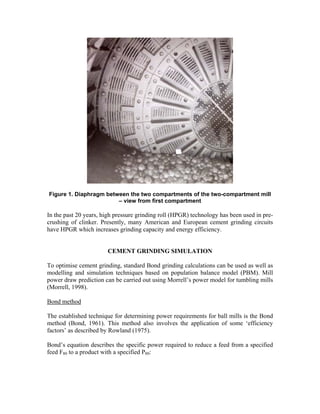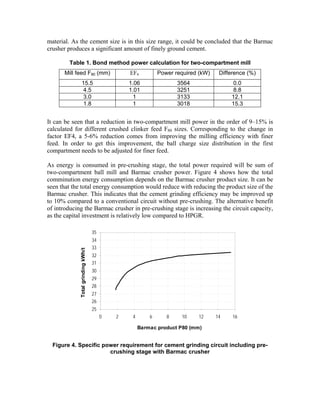This document discusses optimizing cement grinding circuits through pre-crushing of clinker using a Barmac crusher prior to grinding in a two-compartment ball mill. Bond calculations and population balance modeling are used to analyze the potential benefits. Modeling suggests the total energy consumption for grinding can be reduced up to 10% by pre-crushing clinker to a finer size before ball milling. A case study of a cement plant found pre-crushing could lower the required ball mill power by 9-15% and increase grinding circuit capacity with relatively low capital investment compared to alternatives like high-pressure grinding rolls.



![Wm = Wi (
80P
10
-
80F
10
) (1)
where: Wm - is mill specific motor output power (kWh/t),
Wi - is the Bond ball mill work index (kWh/t),
P80 - is sieve size passing 80% of the mill product (µm),
F80 - is sieve size passing 80% of the mill feed (µm),
The “efficiency factors” (Rowland, 1975) modify equation 1 so that it caters for circuit
conditions which are different from that Bond used to develop his original equation.
There are efficiency factors for dry grinding, open circuit ball milling, mill diameter,
oversize feed, grinding finer than 75 microns and too large or too small reduction ratios.
For cement application, the dry grinding (EF1), mill diameter (EF3), oversize feed (EF4)
and fine product (EF5) factors are relevant. Therefore, the equation for the specific power
requirement is:
Wm = EF1 EF3 EF4 EF5 Wi (
80P
10
-
80F
10
) (2)
According to Bond the specific power (calculated using Equation 1) should be multiplied
by EF3 where the mill diameter exceeds 8ft. Rowland (1975) modified the application of
EF3 and stated it should be used up to mills of 12ft. For mills larger than 12ft the value of
EF3 remains constant at the value for 12ft mills.
EF3 = (8/Dft)0.2
= ( ) .2 0 2.44
D
(3)
where: Dft - is the mill diameter inside liners (ft)
D - is the mill diameter inside liners (m)
The oversize feed factor (EF4) caters for situations where the feed size is coarser than a
specific size limit (F0), which is a function of ore hardness. Bond argued that if the feed
ore were coarser than this, bigger balls would be needed to break the coarser feed
particles at the expense of grinding of smaller particles. Conversely, if smaller balls were
used to grind the finer particles, the smaller balls would not break the coarser particles.
Either way a grinding inefficiency would result. The EF4 factor is applied only when the
F80 is greater than F0 and has a value greater than 1.
The correction factor, EF4, for the ore feed size is calculated as follows (Rowland, 1975):
EF4 = [Rr + (Wi - 7) (
0
080
F
FF −
)] / Rr (4)
P0 = 4000 (
Wi
13
)0.5
for ball mills (5)
Rr = F80/P80 (6)
where: Rr - size reduction ratio](https://image.slidesharecdn.com/041-140731110403-phpapp01/85/Cement-Grinding-Optimization-4-320.jpg)
![F0 - optimum mill feed size (µm),
F80 - actual mill feed size (µm),
P80 - mill product size (µm),
The correction factor EF5 for the products finer than 75 µm (Rowland, 1975) is
determined by:
EF5 =
80
80
P*1.145
3.10P +
(7)
It was found in the crushing area that there are significant differences between the real
plant data and the Bond calculations and therefore empirical corrections were introduced.
The following modified Bond equation was proposed for crushing (Magdalinovic, 1990):
Wc =
cP
A
Wi (
cP
10
-
cF
10
) (8)
where:
Wc - is energy consumed for clinker crushing (kWh/t),
Wi - is Bond ball mill work index (kWh/t),
Pc -is sieve size passing 80% of the clinker after crushing (µm),
Fc - is sieve size passing 80% of the clinker before crushing (µm),
A - is an empirical coefficient, dependant on clinker and crusher properties
Based on the above considerations for crushing and grinding, the energy consumption for
the clinker pre-crushing and ball milling can be estimated using the following Bond
based model:
W = Wc + Wm (9)
As pre-crushing product size Pc is equal to the mill feed size F80 then:
W =
80F
A
Wi (
80P
10
-
cF
10
) + 1.3 * ( ) .2 0 2.44
D
* {[Rr + (Wi - 7) (
0
080
F
FF −
)] / Rr} *
80
80
P*1.145
3.10P +
* Wi (
80P
10
-
80F
10
) (10)
PBM models
In the area of dry particle reduction, the population balance models (PBM) for crushers,
HPGR, ball mills, air-swept ball mills and air separators have been developed (Lynch et
all 1977, Austin et al, 1980; Zhang,Y et al, 1988, Morrell et al, 1997, Benzer et al, 2001,](https://image.slidesharecdn.com/041-140731110403-phpapp01/85/Cement-Grinding-Optimization-5-320.jpg)
![2003). These models can be used to simulate cement grinding circuits and to assist their
optimisation.
The “work horse” of the cement grinding plant is the two-compartment ball mill,
commonly called the tube mill. Significant advances in model development were
achieved in recent years (Benzer et al, 2001, 2003) through research on industrial scale.
The breakage and transport mechanisms are better understood as well as the classification
action of the diaphragm. Further advances are expected in modelling the effect of
diaphragm design on classification and powder transport.
The basis for modeling the two-compartment ball mill is the perfect mixing ball mill
model. It can be illustrated by the following equation (Lynch, 1997):
i
ii
i
j
jj
d
pr
p
d
pra
f
i
j
ij
i +=+ ∑=
][
1
(11)
where:
fi - feed rate of size fraction i (t/h)
pi - product flow of size fraction i (t/h)
aij - the mass fraction of size that appear at size i after breakage
ri - breakage rate of particle size i (h-1
)
si - amount of size particles inside the mill (tonnes)
di - the discharge rate of particle size (h-1
)
The model consist two important parameter, the breakage function (aij) that describe the
material characteristic and breakage/discharge rate function (ri/di) which defines the
machine characteristics and can be calculated when feed and product size distribution are
known and breakage function is available.
The air classifier controls the final product quality. Therefore, the air classifier has a
crucial role in the circuit and a lot of attention is paid on the design and operation of the
air classifier. The classification action is modeled using the efficiency curve approach
(Lynch, 1997). Effect of the classifier design and operational parameters on the efficiency
is complicated and work is in progress to improve the current models.](https://image.slidesharecdn.com/041-140731110403-phpapp01/85/Cement-Grinding-Optimization-6-320.jpg)






